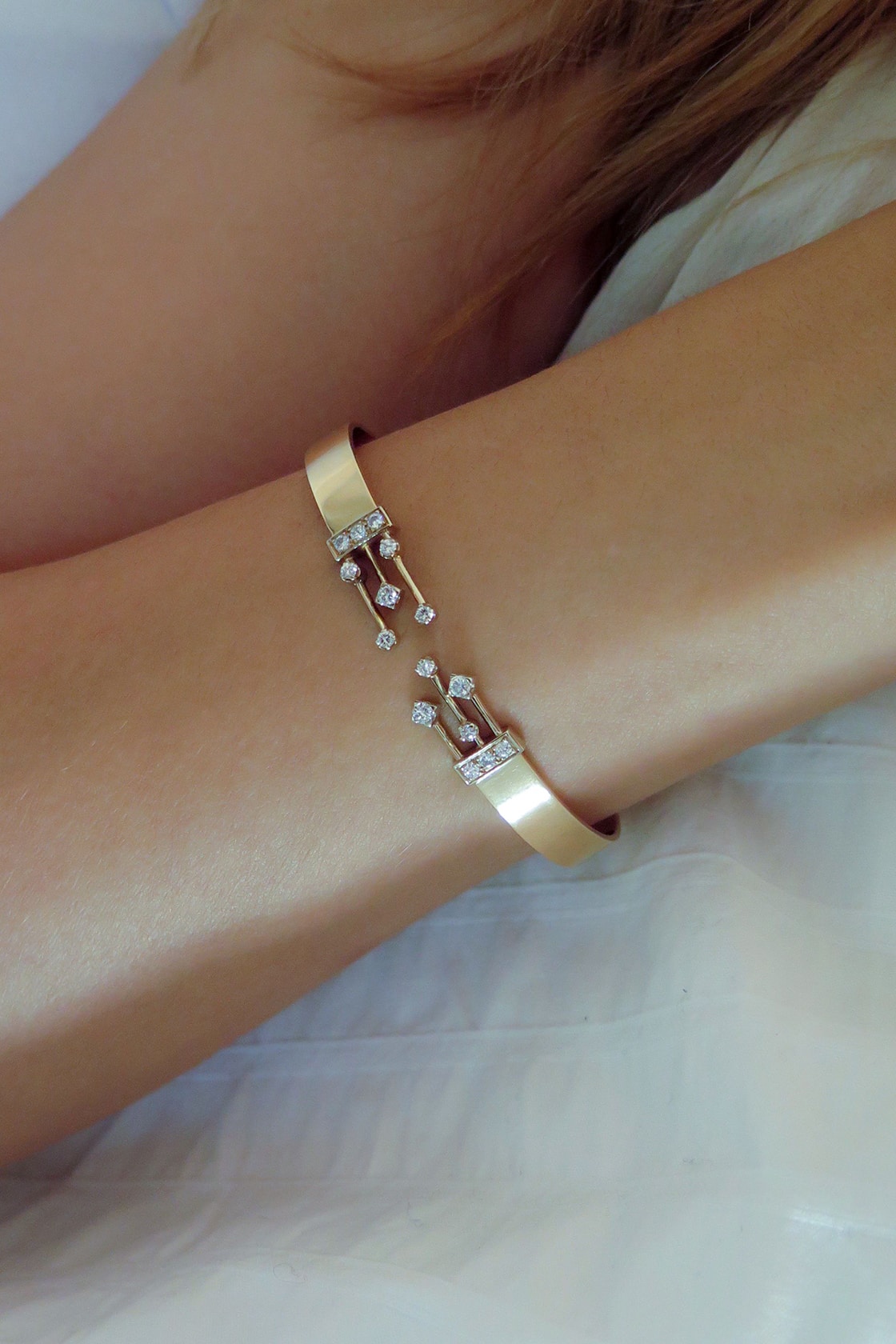Blog
Yellow gold: Where does it come from?
In the world of luxury jewelry, each precious gemstone holds an exceptional story. Among them, one gem stands out for its timeless glow: yellow gold. Where does this gold, coveted for millennia, come from? How has it traversed the ages and civilizations to become the ultimate symbol of wealth and refinement? Through this article, Atelier Bravig takes you on a journey to discover its fascinating heritage, where luxury and beauty intertwine with history and passion.
Geological Formation of Gold
Gold, the precious metal that has captivated humanity for millions of years, has a geological history just as fascinating as its value. To understand its origin, let’s explore the geological process at the heart of its creation, as well as the complex mechanisms that influence its concentration in different regions.
Formation of Gold in the Earth’s Crust
Gold, like most chemical elements, has a cosmic origin. It was created during nuclear fusion in the cores of stars, then dispersed throughout the universe in stellar explosions. Gold is not an abundant element in the Earth’s crust, which partly explains its rarity. However, it primarily forms in two types of deposits: gold veins and alluvial deposits.
Formation in Gold Veins
Gold, in the form of dissolved auric ions, moves within the fissures and faults of underground rocks. When these auric ions encounter favorable conditions, such as variations in pressure and temperature, as well as the presence of reducing gases, they precipitate and solidify into gold particles. Over time, these deposits accumulate to form gold-rich veins.
Formation in Alluvial Deposits
Alluvial deposits result from the erosion of gold veins by natural forces such as water, wind, and gravity. The gold released from the mother rocks is transported by rivers and eventually deposits in riverbeds, sandbanks, or deltas. Miners recover this gold using techniques such as gold panning and gravity separation.
Geological Factors Influencing Gold Concentration
The concentration of gold in different regions is the result of various geological factors:
- Geological movements (such as those in active tectonic zones, where the lithosphere moves and forms fissures that aid in gold accumulation),
- Local geochemical conditions that influence gold concentration in a given region. Gold prospectors often need to conduct in-depth geological studies to identify promising areas.
Gold Extraction
The extraction of gold has been an essential process throughout human history, sparking gold rushes and epic quests in search of this precious metal. Today, gold extraction methods have evolved to adapt to technological advancements while still facing environmental and social challenges.
Historical Gold Extraction Methods
In the past, gold extraction was mainly done through artisanal methods such as panning, where gold was extracted from river sediments. Extraction techniques later became more sophisticated with the advent of underground mining, including shafts and galleries to reach deeply buried gold veins.
Modern Gold Extraction Techniques
Today, gold extraction has undergone a radical transformation. One of the most common methods is open-pit mining, where large areas of land are excavated to access gold deposits. Gold can also be extracted from low-grade ores using sophisticated chemical and physical processes, such as cyanide leaching and flotation.
Environmental and Social Aspects
Gold extraction, despite its economic benefits, carries significant environmental consequences. The use of cyanide in leaching can lead to soil and groundwater contamination, endangering local ecosystems. Open-pit mining can also degrade natural landscapes and affect local communities.
On the social front, gold extraction can impact the rights of indigenous populations, miners’ working conditions, and the stability of local communities. Responsible mining companies today strive to mitigate these negative impacts by implementing strict environmental and social responsibility standards while seeking less damaging alternatives.
Major Gold-Producing Countries
Gold-producing countries play a significant role in the global gold industry. Among the different countries, the top five include:
- China (approximately 330 tons)
- Australia (approximately 320 tons)
- Russia (approximately 320 tons)
- Canada (approximately 220 tons)
- United States (approximately 170 tons)
These countries hold prominent positions in gold production for several reasons:
- The presence of rich and exploitable gold deposits.
- Investments in modern mining technologies to enhance extraction efficiency.
- Domestic demand, political and economic stability, and mining regulations maintain their dominant positions.
Gold production is influenced by various economic factors. Higher gold prices lead to increased investments in exploration and extraction. Exchange rate fluctuations, labor costs, environmental regulations, and sustainability concerns are also key elements affecting gold production.
Refining and Transformation of Raw Gold
The refining of raw gold is a meticulous process aimed at extracting pure gold from impurities that accompany it in its raw form. This process typically begins with melting the ore or gold bars in a high-temperature crucible, allowing impurities to separate and form slag. Once cooled, the molten gold is poured into molds to form gold bars, the initial stage of the transformation process.
The refining of raw gold is a meticulous process aimed at extracting pure gold from impurities that accompany it in its raw form. This process typically begins with melting the ore or gold bars in a high-temperature crucible, allowing impurities to separate and form slag. Once cooled, the molten gold is poured into molds to form gold bars, the initial stage of the transformation process.
In the gold refining industry, quality is crucial. Strict standards and quality certifications, such as the hallmark or LBMA (London Bullion Market Association) certification, ensure that gold reaches a high degree of purity, typically 99.99% or more, in accordance with international standards. These certifications assure buyers that the gold they acquire is genuine, pure, and compliant with required specifications.
From Origins to the Modern World: Uses of Gold in Societies
Gold has held immeasurable importance in various aspects of society for centuries.
- Traditional Uses : Traditionally, gold has been used to create jewelry and ornaments, symbolizing beauty, prestige, and wealth. This tradition continues to this day, with exquisitely crafted jewelry creations that continue to charm the world.
- Modern Uses : Gold has also found its place in modern fields. In the medical field, it is used in surgery for implants and precision instruments due to its biocompatibility. In the electronics industry, gold is an essential component of electrical connections, thanks to its conductivity and resistance to corrosion. In aerospace, its use in reflective coatings protects satellites from harmful radiation.
Gold, a universal symbol of wealth and elegance, evokes both the grandeur of past civilizations and the timeless refinement of contemporary jewelry. With exquisite craftsmanship and a commitment to quality and aesthetics, Atelier Bravig continues to celebrate the splendor of this precious yellow gold through unique creations.
Source for gold-producing countries: https://fr.statista.com/statistiques/565207/production-d-or-classee-par-principaux-pays-producteurs/

 Français
Français




